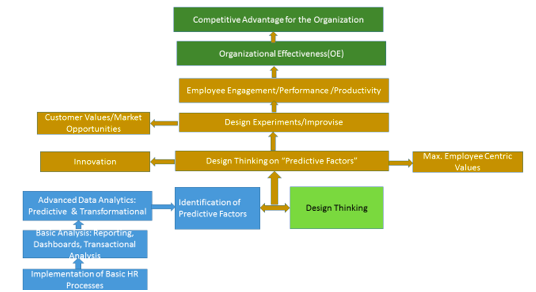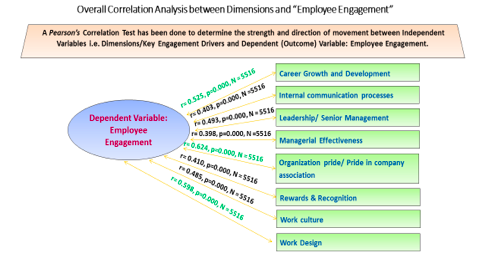Data science and analytics have increasingly gained significance in the measurement and prediction of business outcomes. The advantage of data science and analytics is embedded in making and executing critical decisions. However, the long-lasting success of implementation of decisions depends first on the identification of predictive factors, which have a greater impact on the business outcomes. These outcomes can be in various domains of business and management, that is, marketing, sales, finance, customer relationship management, supply chain management, business operations, clinical trials, human capital and so on.
Let us focus on the emergence of the organisational effectiveness (OE) model as the synthesis of human capital/talent analytics and design thinking. The organisations can reap optimum benefits only through the amalgamation of these two approaches mentioned in the following diagram:

In isolation, the application of each approach has limitations. The ‘analytics’ provides insights and decision parameters, while the predictive analytics ascertains the predictive and transformative factors, which have higher predictability, explanatory power and impact for the outcomes. The complexity of current business processes is the outcome of interplay of a plethora of causative factors. As the constituents and determinants, these factors have relative importance in terms of explanatory power for business outcome. Thus, for resource optimisation in terms of physical, economical, financial and human resources which are scarce, it is imperative for the organisations to focus on most predictable variables or factors, which are the prime causative factors for the business results. As the first step, the identification of these key determinants is important, before focussing on the most significant and dominant causative parameters for the business outcomes.
The identified predictive factors have to be viewed and re-looked with greater focus and the application of ‘design thinking’ on these identified ‘predictive factors’ can play a critical role in order to ensure maximum benefits for the organisation. Thus, the combination of design thinking, design experiments, action planning and effective execution can lead to organisational productivity and performance, and consequently, organisational effectiveness and competitive advantages for the organisation.
Design thinking associated with predictive parameters
The significance of design thinking and predictive analytics can be better understood with the example provided in the integrated talent management domain. Based on the following empirical research (multiple regression equation) conducted by the author, it has been found that the work design (WD) has stronger predictability in measuring and explaining ‘employee engagement’, which is defined as the degree of contentment, positive attitude, commitment and involvement of the employees towards the organisation and its various subsystems. The ‘work design’ measures the extent to which there is role clarity, autonomy to fulfill tasks and responsibilities, attainment of superordinate goals, a sense of meaningfulness and accomplishment from the work performed.
In the following diagram, Pearson’s Correlation has been used to determine the strength and direction of correlation among the independent variables i.e. dimensions/key engagement drivers and dependent (Outcome) variable: Employee Engagement (commitment & involvement).

As per the above analysis, Work Design emerges as a relative strength area. Thus, ‘design thinking’ with the objective of maximising the employee-centric values through the process of innovation and reengineering or improvement, should be adopted to strengthen it further as it is directly correlated to employee engagement, commitment & involvement. Focus should be directed towards specific items/elements, where satisfaction % is found to be low, for instance, ‘Employees’ sense of accomplishment from their work and clarity on how their work contributes to the company’s success needs improvement’.
In terms of predictive modeling, regression analysis has been carried out to ascertain the causal relationship among independent variables i.e. dimensions/key engagement drivers and dependent (outcome) variable: employee engagement. Multiple regression helped determine dimensions that are strong predictors of employee engagement, commitment & involvement.
Based on the Regression Equation* below, the effect of work design (b=.390, p=.01) is significant (significance level at 0.01) and its positive coefficient (.390) indicates that it’s a strong predictor for employee engagement. Greater scores on work design will lead to higher scores on employee engagement.
*Employee Engagement = 0.890 + 0.105 (CGD) + 0.0149 (ICP) -0.0111 (SM) + 0.0139 (ME) + .443 (OP) + 0.0155 (R&R) -0.0567 (WC) + .390 (WD)
Where CGD= career growth & development, ICP=internal communication process, SM= senior management, ME=managerial effectiveness, OP=organisational pride, R&R= reward and recognition, WC= work culture, and WD= work design.
After the determination of ‘work design’ as one of the most significant predictive factors for ‘employee engagement’, this company X (an Information Technology Company) used ‘design thinking’ efforts in terms of ‘work re-design’ and based on further comparative analysis of one-half years of gap, the ‘work-redesign’ lead to 12 per cent increase in ‘employment engagement’ level.
Thus, in order to enhance ‘employee engagement’, it is critical for the organisations to provide greater impetus to the ‘work design’ and the ‘design thinking’ can play significant role in terms of ‘work re-design’. Depending upon organisational needs in terms of nature of jobs and levels, the design thinking can help determine the appropriate approach for work design and this will lead to greater employee engagement, which is critical for employee performance and productivity and eventually, organisational effectiveness & competitive advantage for the organisation.


